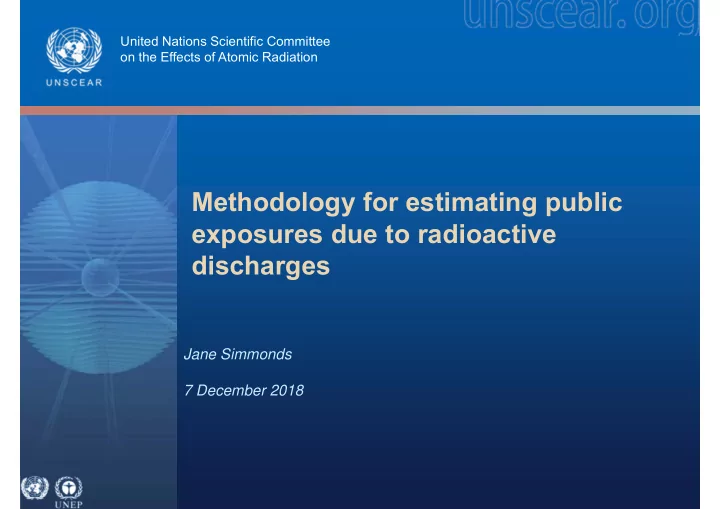

United Nations Scientific Committee on the Effects of Atomic Radiation Methodology for estimating public exposures due to radioactive discharges Jane Simmonds 7 December 2018
Background • UNSCEAR has used a series of methodologies for many years to carry out radiological assessments. • In 2008 the committee decided to update the methodology and to use it to assess radiation exposures from electricity generation. • Work took many years with a delay due to the need to concentrate resources on the Fukushima assessment • Methodology published as part of the UNSCEAR 2016 report.
Aim of methodology • To assess individual and collective doses from routine (continuous) discharges to environment. • Characteristic individuals not representative person • For use by Committee for worldwide assessments not all situations and uses (not for accidents, risk assessments or regulatory purposes). • Discharges to atmosphere, rivers, lakes and seas.
Requirements • Methodology should be robust, transparent and applicable to different electrical energy sources • It should build on previous methodologies taking account of updates in the field • Doses per unit discharge should be provided for key radionuclides • Although intended for global application regional variations should be considered • Methodology implemented through Excel workbooks.
Input and review • A number of people involved: – Consultants – Technical review committee – UNSCEAR Member states – Secretariat • Workbooks developed by staff from Public Health England in the UK
Characteristic Individual • Aim to represent “average” person not “representative person” / “critical group” • Live 5 km from discharge point for atmospheric discharges • Live in area around receiving water body for aquatic discharges • 25 % of food is locally produced
Radionuclides considered • 29 important radionuclides for routine discharges from all energy sources • Global circulation considered for tritium, carbon-14, krypton-85 and iodine-129 • Included progeny notably for radon-222, thorium-232 and uranium-238
Endpoints • Characteristic individual effective dose in the 100 th year of discharge at a rate of 1 Bq/s (Sv) • Collective doses (man Sv) integrated to 100 y from discharge at a rate of 1 Bq/s for 1 year (local and regional) • For globally circulating radionuclides only collective dose integrated to 100, 500 and 10,000 years.
Exposure pathways • Discharge to atmosphere: – Inhalation – External exposure to radionuclides in the cloud and deposited on the ground – Ingestion of terrestrial foods • Discharge to water bodies: – Ingestion of aquatic foods and drinking water (freshwater bodies only) – External exposure from radionuclides on freshwater and marine sediments – Irrigation of terrestrial foods
UNEP Regions
Regional information • Six regions considered (Africa; Asia and Pacific; Europe; Latin America and Caribbean; North America; West Asia) plus “world average”. • Population distributions (default plus around nuclear power stations) • Per-caput consumption rates of terrestrial foods, marine and freshwater foods • Irrigation rates and transfers
Limitations of methodology • Generic intended for use throughout world not for site specific studies • Aim to be as realistic as possible – hard to quantify uncertainties. • Characteristic individual doses dependent on 25% local food assumption • Collective doses dependent on population distributions • Many other factors discussed in report.
Individual dose – marine discharge Sv (1 Bq/s for 100 y) Region Carbon-14 Polonium-210 Africa 3.2 10*-11 1.0 10*-8 Asia and Pacific 1.0 10*-10 1.4 10*-7 Europe 9.4 10*-11 7.5 10*-8 Latin America 4.5 10*-11 4.0 10*-8 North America 1.1 10*-10 1.5 10*-7 West Asia 2.6 10*-11 1.3 10*-8
Collective dose atmospheric discharge Caesium-137 man Sv Region Local Regional Africa 3.5 10*-5 1.7 10*-4 Asia and Pacific 1.4 10*-4 6.8 10*-4 Europe 7.9 10*-5 3.8 10*-4 Latin America 7.6 10*-5 3.6 10*-4 North America 2.2 10*-5 1.0 10*-4 West Asia 5.0 10*-5 2.4 10*-4 World average 8.5 10*-5 4.1 10*-4
Ackowledgements • Current methodology builds on previous work of the Committee and takes account of valuable comments from Member States plus material provided. • Significant input by previous consultants, PHE staff, other experts and members of the Expert Group as well as from the secretariat.
Recommend
More recommend